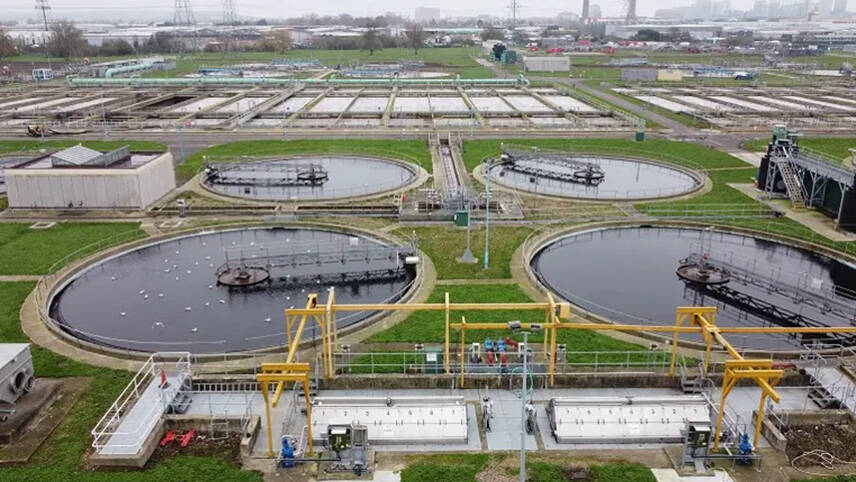Register for free and continue reading
Join our growing army of changemakers and get unlimited access to our premium content

Image: Thames Water
Thames Water has this week announced that two of its STWs have been retrofitted to convert sewage sludge into biomethane.
The Hogsmill STW in Syrret and the Beddington STW in Sutton will collectively create enough biomethane to export electricity for more than 2,000 homes.
Thames Water worked with UK Power Networks to upgrade electricity network capacity and turn the sites into “poo power plants”. The system works by separating sludge from the liquid at the STW and treating it in heated, digestor tanks to kill bacteria. The heating process creates biomethane which will be exported to power engines which are connected to electricity generators.
The power generated will first be used at the Thames Water sites, to offset energy usage, with the remainder sent to power homes and businesses. Thames Water has already converted STWs at Beckton and Maplelodge.
Thames Water’s head of wastewater treatment, South Lond, Ian Ruffell said: “We are thrilled to introduce poo power as a source of energy from two sites in southwest London, as we look to play a role in the future of renewable energy.
“The successful use of biomethane conversion at Hogsmill and Beddington shows the dedication of our teams to delivering this project and our own commitment towards reducing our carbon footprint.”
Thames Water currently collects 4.6 billion litres of wastewater daily. The company generated 536GWh of renewable energy in 2023, which accounted for 27% of its energy needs.
Something in the air
In related news, European airline Wizz Air has announced the next phase in its plan to invest £5m to source biofuel for sustainable aviation fuel (SAFs) from Firefly.
The partnership will see Firefly convert sewage sludge into SAFs for Wizz Air’s UK operations from 2028. The deal covers 525,000 tonnes of SAF over 15 years, which could save 1.5m tonnes of CO2.
The Guardian is reporting that Firefly will use a pilot refinery in Harwich to source sewage waste from Anglian Water and turn it into aircraft fuel.
The SAFs will be certified against leading RSB standards and could cut emissions by 90% compared to conventional fossil-based jet fuel over its lifecycle.
Firefly aims to have its first commercial plant operating within the next five years and notes that more than 57 million tonnes of sewage sludge produced annually in the UK could produce around 250,000 tonnes of SAFs annually.
Wizz Air is aiming to reduce its carbon emissions per passenger/km by 25% by 2030. At the start of the year, Wizz Air entered into a new agreement with Neste to purchase and use SAFs from 2025 onwards. The agreement gives the airline the purchasing option of more than 36,000 tonnes of SAFs annually.
Organisations backing SAFs claim that the solution can reduce life-cycle emissions by up to 80% compared to traditional jet fuel. However, most airlines currently only use it in small proportions in blends – partly due to a lack of supply and partly because current international regulations limit biofuel blends to 50%.


I’m not a sewage sludge expert. What would the process have been before this change? Is this creating more methane or utilizing what they would already produce and presumably leak into the atmosphere?
Thanks
Andrew, The sewage gas produced is predominantly a mixture of CH4 (methane) and CO2 produced by STW’s. It is not leaked, but often used to power biogas CHP engines to produce electricity. However, like any internal combustion engine, the CHP’s do emit CO2 during combustion, but the CH4 is for all intents and purposes, “burned” in the combustion process.
You may also be interested in my reply, following.
Comparatively, sewage sludge is inherently low in energy and the net energy balance of most STW’s often does not allow for energy to be exported, but used internally at the treatment works.
However, sewage sludge to biomethane injection into the national gas grid has been successfully undertaken at Severn Trent’s Minworth plant for about a decade. A few other STW’s around the UK have taken a similar approach, but this was only financially viable when the RHI tariffs for GS(M)R biomethane injection to grid were high in the period 2013-15.
This report states that biomethane is being produced to generate electricity “for more than 2,000 homes.” Why do this when the engines could run on the biogas produced, before upgrading to GS(M)R compliant biomethane? The conversion efficiency of biomethane to electricity in CHP engines is between 35% – 44%, but the conversion efficiency of using biomethane to heat homes in domestic boilers or cook with is c.89-90%.
Either this report is not presenting the full facts, or this project seems like it has been put together for the purpose of extracting payments from the Green Gas Support Scheme (paid out of the public purse) because the feed in tariff incentives for producing electricity from biogas are no longer available.
Forgive the pun, but something doesn’t smell right here.
Thames Water and its parent company are in financial difficulties and it’s future appears to be uncertain. It would be of concern if, even in a small way, public funds from the Green Gas Support Scheme are being used to underpin the business.